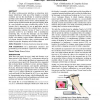Free Online Productivity Tools
i2Speak
i2Symbol
i2OCR
iTex2Img
iWeb2Print
iWeb2Shot
i2Type
iPdf2Split
iPdf2Merge
i2Bopomofo
i2Arabic
i2Style
i2Image
i2PDF
iLatex2Rtf
Sci2ools
51
Voted
CHI
2010
ACM
2010
ACM
Occlusion-aware interfaces
We define occlusion-aware interfaces as interaction techniques which know what area of the display is currently occluded, and use this knowledge to counteract potential problems and/or utilize the hidden area. As a case study, we describe the Occlusion-Aware Viewer, which identifies important regions hidden beneath the hand and displays them in a non-occluded area using a bubble-like callout. To determine what is important, we use an application agnostic image processing layer. For the occluded area, we use a user configurable, real-time version of Vogel et al.’s [21] geometric model. In an evaluation with a simultaneous monitoring task, we find the technique can successfully mitigate the effects of occlusion, although issues with ambiguity and stability suggest further refinements. Finally, we present designs for three other occlusion-aware techniques for pop-ups, dragging, and a hidden widget.
| Added | 03 Jul 2010 |
| Updated | 03 Jul 2010 |
| Type | Conference |
| Year | 2010 |
| Where | CHI |
| Authors | Daniel Vogel, Ravin Balakrishnan |
Comments (0)

